


 |

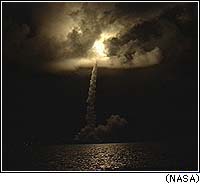
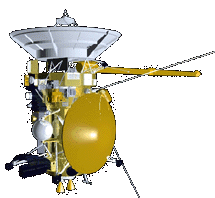 Saturn is ten times farther from the Sun than the Earth (about 900,000,000 miles). The Cassini probe will take a roundabout way to get to Saturn, traveling 2 billion miles to get there, 6.7 years after the launch. The spacecraft will fly by the planet Venus twice at 30,660 mph (13 km/s), return an fly by the Earth, and also visit the planet Jupiter for a flyby on New Year's Eve of 2000. These flyby's are the famous NASA
"gravity assist"
techniques designed to "steal" energy from celestial bodies.
Saturn is ten times farther from the Sun than the Earth (about 900,000,000 miles). The Cassini probe will take a roundabout way to get to Saturn, traveling 2 billion miles to get there, 6.7 years after the launch. The spacecraft will fly by the planet Venus twice at 30,660 mph (13 km/s), return an fly by the Earth, and also visit the planet Jupiter for a flyby on New Year's Eve of 2000. These flyby's are the famous NASA
"gravity assist"
techniques designed to "steal" energy from celestial bodies.
 To fly into space a spacecraft has to overcome the gravity pull of the earth. The escape speed is about 11 km/sec. The best rocket currently available can only impart enough kinetic energy to the Cassini spacecraft to accelerate it to about 4 km/sec. Cassini is about the size and mass of a bus (5650 kg). With the limited kinetic energy that the craft receives from the launch rocket it would be limited to the planetary environments that NASA visited in the 1960's: Venus, Mars, and Jupiter. Using "gravity assist", a concept developed in the late 1960's, a visit to all the planets is now possible. We only have to pay an energy price to reach the first planet; the rest of the trip is free.
To fly into space a spacecraft has to overcome the gravity pull of the earth. The escape speed is about 11 km/sec. The best rocket currently available can only impart enough kinetic energy to the Cassini spacecraft to accelerate it to about 4 km/sec. Cassini is about the size and mass of a bus (5650 kg). With the limited kinetic energy that the craft receives from the launch rocket it would be limited to the planetary environments that NASA visited in the 1960's: Venus, Mars, and Jupiter. Using "gravity assist", a concept developed in the late 1960's, a visit to all the planets is now possible. We only have to pay an energy price to reach the first planet; the rest of the trip is free.
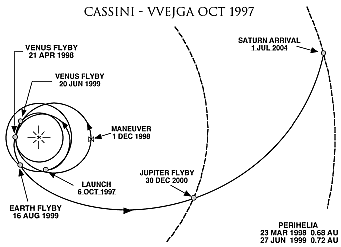 The Cassini space craft will use this gravitational slingshot effect four times on its trip to Saturn. It will fly by Venus in April 1998 and again in June 1999. After the second Venus flyby the craft will approach the Earth and fly by in August 1999. It will then have enough energy to reach Jupiter on December 30, 2000 where the last of the four flybys will propel it towards Saturn where it will arrive in July, 2004. It will then insert itself into an orbit around
Saturn.
The four flybys will gain the craft an energy equivalent of 75 tons of rocket fuel. Over 99 present of the Cassini's trip will be unpowered. Click on the trajectory picture for a large scale version of the trajectory and the project timeline.
The Cassini space craft will use this gravitational slingshot effect four times on its trip to Saturn. It will fly by Venus in April 1998 and again in June 1999. After the second Venus flyby the craft will approach the Earth and fly by in August 1999. It will then have enough energy to reach Jupiter on December 30, 2000 where the last of the four flybys will propel it towards Saturn where it will arrive in July, 2004. It will then insert itself into an orbit around
Saturn.
The four flybys will gain the craft an energy equivalent of 75 tons of rocket fuel. Over 99 present of the Cassini's trip will be unpowered. Click on the trajectory picture for a large scale version of the trajectory and the project timeline.
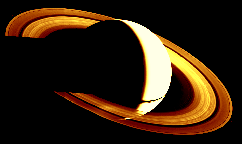 The Cassini is carrying a suite of scientific instruments and communication equipment, including the Huygens probe, supplied by the European Space Agency. During the time of its mission Cassini will collect and transmit back to Earth an amount of scientific data equivalent of 800 sets of encyclopedia Brittanica. Images and data related to the physical properties of Saturn, its rings and its satellites will be collected.
The Cassini is carrying a suite of scientific instruments and communication equipment, including the Huygens probe, supplied by the European Space Agency. During the time of its mission Cassini will collect and transmit back to Earth an amount of scientific data equivalent of 800 sets of encyclopedia Brittanica. Images and data related to the physical properties of Saturn, its rings and its satellites will be collected.
While Cassini will collect data all through its long journey, the heart of the mission is the tour of the
Saturn environment.
In addition to its famous rings Saturn has many interesting satellites. Some flybys of these are planned to examine their features. Cassini will also orbit Saturn several dozen times, passing through the gaps in the rings. 19 days before its arrival to Saturn the space craft will swing by Saturn's most distant moon, Phoebe.
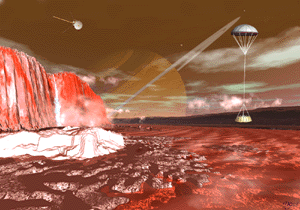
 2.
2.  3.
3. 
 1.What was the average acceleration of the Cassini probe during launch?
1.What was the average acceleration of the Cassini probe during launch?
 2. 2.What will be the speed of the Cassini probe as it approaches Saturn?
2. 2.What will be the speed of the Cassini probe as it approaches Saturn?
 3.Could you pick up the signals from the Cassini transmitters on an FM radio? If not, why not?
3.Could you pick up the signals from the Cassini transmitters on an FM radio? If not, why not?
 4.What chemical elements are most abundant in the Titan atmosphere?
4.What chemical elements are most abundant in the Titan atmosphere?